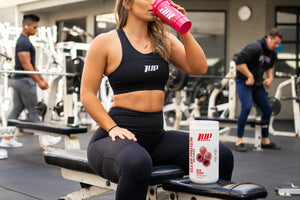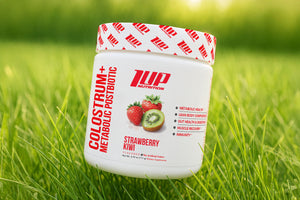Anyone who has ever spent a considerable amount of time in the gym has developed their own fair share of bumps, bruises, aches, and pains. When these little “bumps” in the road to health and wellness pop up, we often turn to conventional means of relief like icing, heating, foam rolling, and stretching.
However, a new form of recovery therapy has started to catch fire -- one whose beginnings started over 3000 years ago!
It’s called cupping therapy and we’ve got all the details on this popular recovery protocol.
What is Cupping Therapy?
Cupping is an alternative form of non-pharmaceutical therapy rooted in Traditional Chinese Medicine, most frequently used as an adjunct therapy to conventional medicine.
It involves placing heated cups on the skin to create suction, which increases blood circulation and promotes healing through the flow of “qi” -- the Chinese word for “life force.”
The increase in blood flow to the cupped areas of the body are believed to help relieve muscle tension and support cellular repair. It may also help develop and fortify connective tissue and encourage the formation of new blood vessels, which further enhances circulation throughout the body.
Practitioners of Traditional Medicine believe that cupping helps balance yin and yang within the body, and by restoring balance, the body’s resistance to pathogens is increased and pain is decreased.
How Does Cupping Work?
Cupping has been practiced for thousands of years, some accounts even go as far back as 1500 BC!
In the early days, animal horns were used, and as time passed, the horns were replaced by bamboo cups and then ceramic cups. These days, glass cups are the typical implement used by practitioners.
Cupping is performed in one of two distinct ways:
- Dry Cupping -- involves suction only
- Wet Cupping -- involves suction and controlled medicinal bleeding
Regardless of which form of cupping you try, the process all starts the same.
A cupping practitioner places a flammable substance (alcohol, herbs, paper, etc.) in a glass cup and sets the substance on fire.
As the fire burns, the heat generated warms the cups, and once the fire burns out, the cup is placed upside down on your skin.
As the air inside the cup cools, a vacuum is created resulting in suction of the cup to your skin, which then leads to your skin being pulled up and into the cup. This suction also has the added effect of increasing blood flow to the area where the cup was placed.
Now, it’s worth mentioning that not all modern practitioners use the cupping by fire approach. Some utilize machine pumps with silicone cups that can be moved up and down the body, creating a massage-type experience.
The first time you try cupping, you will receive only three to five cups. However, as you become more experienced with the procedure, you may have as many as seven cups placed on you.
Now, here’s where the big difference between dry and wet cupping occurs.
For dry cupping procedures, cups are kept in place for 5-10 minutes and then removed.
However, with wet cupping, the cups remain in place only around 3-5 minutes before they are removed and the cupping practitioner makes a small incision at the site of the cup to draw blood. Following, the cupping practitioner will apply some antibiotic ointment and a bandage to prevent any infection from setting in.
While the thought of “bloodletting” might sound ever so slightly terrifying, proponents of cupping subscribe to the belief that doing so helps cleanse and purify the body of toxins, further promoting healing, though this has not been proven in any scientific research to date.
A third and less common variation of cupping called “needle cupping” has started to pop up. In this form of cupping, the practitioner first inserts a needle used for acupuncture into the skin and then places a cup over it.
What Are the Benefits of Cupping?
Cupping has been used for centuries for a whole host of issues, including skin conditions and minor aches and pains.
A recent research review found limited evidence that cupping may be beneficial for a variety of conditions[1], including:
- Acne
- Coughing
- Difficulty breathing (dyspnea)
- Partial paralysis of the face
- Lumbar disc herniation
- Age-related wearing of spinal discs (cervical spondylosis)
May Promote Faster Recovery
Additional research from 2018, appearing in the Journal of Alternative and Complementary Medicine, found that cupping therapy improved recovery in professional athletes. More specifically, cupping therapy was reported to help increase range of motion, reduce the perception of pain, and decrease levels of creatine kinase -- an important biomarker of muscle damage.[2]
Researchers do mention that more studies are needed to fully vet any potential benefits of cupping therapy for athletes though.
Pain Relief
Beyond sports recovery, cupping may be an appealing alternative protocol for those looking for relief from everyday aches and pains.
A number of studies have found that cupping therapy may reduce pain[3,4], and a 2018 meta-analysis suggests that it may be a “promising method” of treatment for those suffering from chronic back pain. [5]
As noted before, though, researchers in these studies continue to mention the need for a greater number of higher-quality studies to fully determine the true utility and effectiveness of cupping.
Is Cupping Safe?
Cupping appears to be a relatively safe adjunct therapy to add to your current lifestyle, provided that you are seeking cupping therapy from a well-practiced and qualified individual.
Minor side effects have been reported in the literature, including[6,7]:
- Skin discoloration
- Headaches
- Dizziness
- Fatigue
- Nausea
- Insomnia
There is also the possibility of scarring and infection if trying the wet-cupping protocol that involves small incisions into the skin.
Again, the research into cupping is still in its infancy, so it’s difficult to really know what side effects may or may not result from cupping.
Takeaway
Cupping is an ancient practice that has experienced a revival recently. There is some evidence it may be helpful and provide relief in certain instances, but further research is needed to fully vet the pros and cons of cupping therapy.
References
- Cao H, Li X, Liu J. An Updated Review of the Efficacy of Cupping Therapy. Malaga G, ed. PLoS ONE. 2012;7(2):e31793. doi:10.1371/journal.pone.0031793.
- Bridgett, R., Klose, P., Duffield, R., Mydock, S., & Lauche, R. (2018). Effects of Cupping Therapy in Amateur and Professional Athletes: Systematic Review of Randomized Controlled Trials. Journal of Alternative and Complementary Medicine (New York, N.Y.), 24(3), 208–219. https://doi.org/10.1089/acm.2017.0191
- Kim JI, Lee MS, Lee DH, Boddy K, Ernst E. Cupping for treating pain: a systematic review. Evid Based Complement Alternat Med. 2011;2011:467014. doi:10.1093/ecam/nep035
- Kim S, Lee SH, Kim MR, et al. Is cupping therapy effective in patients with neck pain? A systematic review and meta-analysis. BMJ Open. 2018;8(11):e021070. Published 2018 Nov 5. doi:10.1136/bmjopen-2017-021070
- Moura CC, Chaves ÉCL, Cardoso ACLR, Nogueira DA, Corrêa HP, Chianca TCM. Cupping therapy and chronic back pain: systematic review and meta-analysis. Rev Lat Am Enfermagem. 2018;26:e3094. Published 2018 Nov 14. doi:10.1590/1518-8345.2888.3094
- "Cupping." NCCIH, 9 Nov. 2018, nccih.nih.gov/health/cupping.
- Aboushanab, T. S., & AlSanad, S. (2018). Cupping Therapy: An Overview from a Modern Medicine Perspective. Journal of Acupuncture and Meridian Studies, 11(3), 83–87. https://doi.org/https://doi.org/10.1016/j.jams.2018.02.001






